Intel Confirms Some Details about 28-Core 5 GHz Demonstration
by Ian Cutress on June 8, 2018 12:45 AM EST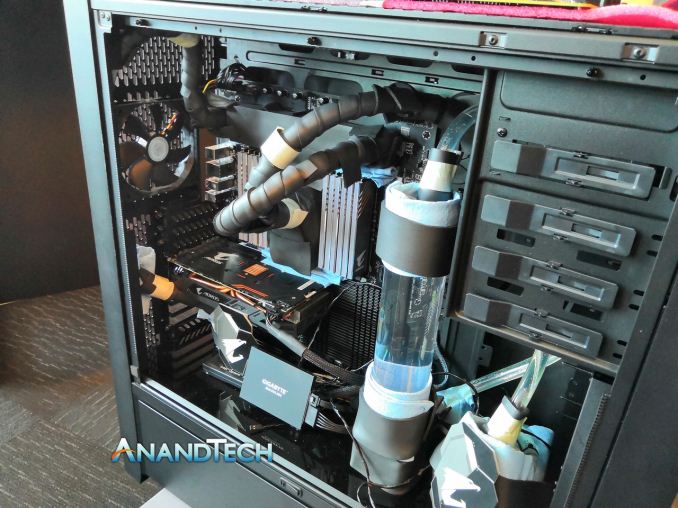
When Intel demonstrated its 28-core system running at 5 GHz at the Computex 2018 keynote this week, there were many questions surrounding the hardware and what was required in order to showcase this. The presentation was relatively light on details – perhaps purposefully so – however Intel SVP and GM Gregory Bryant stated that the processor was set to come out during Q4.
You can read our coverage about the launch in this article:
Intel's 28-Core 5 GHz CPU: Coming in Q4: Link
We also had a chance to examine the system that the demo was run on, in particular the cooling method and the motherboard. We have this article here:
We Got A Sneak Peek on Intel's 28-Core: All You Need to Know: Link
Now there were obviously a lot of questions about the demonstration. Was the CPU overclocked? What cooling was used? What platform did it run on? Which motherboard did it run on? What architecture is being used? What process node? What was the power consumption? We met with an Intel representative yesterday who answered some of these questions.
Was the CPU Overclocked?
The Intel representative did confirm the CPU was overclocked. We were told that on stage the presenter was actually meant to clarify that the system was overclocked, however the specific wording was not stated as it had been prepared.
There are many ways to interpret this – we did tell Intel that we had hoped that the presenter would have spent more time on stage talking about the system in play, discussing the platform it was running on, and making the system more ‘bright’ inside so that people could determine several things from photographs, rather than it looking almost like a black box with hidden pipes. Our commentary was taken on board by the Intel team we spoke to.
What cooling was used?
Intel confirmed that a water chiller was used, which we saw in our system demo examination the day after the presentation. We were told that it was not intended to showcase the cooling on the stage due to time constraints, to which we responded that Intel’s implementation of pre-overclocked systems in the past are typically accompainied a discussion on the pre-overclocked nature and the cooling used in the past, yet this presentation did not have this.
In our pre-briefing it was stated that this was a technical showcase (the bit where it was stated that this was coming to market was a bit of a shock if we’re honest), however this was not communicated as well as it should have been on stage. Again, Intel stated that they were taking our comments on board.
What Platform Did It Run On?
Intel did not answer this platform directly, however it was clear that the CPU was aimed at the LGA3647 server-based socket given from our examination of the demo system. It was unclear how Intel was going to promote this as an extreme workstation-type system, however Intel did note that they expect only a select market to be interested in this type of processor: a niche of a niche.
Intel know very well that there is a crowd of its customers that will buy performance at any price, and it doesn’t take a leap to suggest that this part is for those users.
Which Motherboard Did It Run On?
At the time of the presentation, Intel stated that they had partnered with both ASUS and GIGABYTE to create systems around the new 28-core product, however they didn’t state which system the 5 GHz demo was run on. We heard from both of the motherboard companies that it was actually the GIGABYTE system that hit 5 GHz, however it was noted that Intel did not explicitly call out the partner that hit the milestone. GIGABYTE confirmed that they certainly hit 5 GHz; we have yet to speak to ASUS on the matter. We do know that Intel quickly removed the CPUs in the demo systems from ASUS and GIGABYTE the next day with little notice. In between those times we have seen videos published from LinusTechTips (on ASUS) and Paul’s Hardware (on GIGABYTE) showing a Cinebench run.
What Architecture Did It Run? What Process Node?
The only item that Intel would confirm here is that the 28-core processor is built on one of its 14nm nodes. For anyone thinking it was a 10nm node, this confirms that it was not, however it does not say much more; Intel is purposefully keeping its cards close to its chest on this one. The smart money seems to be that the chip is likely to at least be based on the Skylake-X processors, like the 28-core Xeon Platinum 8176 or Xeon Platinum 8180, rather than the future Cascade Lake platform, however Intel has also promised that the consumer version of Cascade Lake-X will be coming by the end of the year.
Speaking with the motherboard vendors and OEMs in general about Intel’s HEDT plans is a tricky business, but most seem to be focused on their current X299 motherboards right now rather than a series of X299 refreshes that normally accompany an HEDT update.
What was the Power Consumption?
Again, this was one of the items that Intel wants to keep close to its chest. After confirming that the 5.0 GHz number was an overclocked value, it does mean that the base TDP for a ‘retail’ processor will be much lower, as the chip will be running at much lower clocks. The Xeon Platinum 8180 has a base frequency of 2.5 GHz and a turbo of 3.8 GHz for a TDP of 205W (TDP being defined at the base frequency only), and we know that the LGA3647 socket by its Intel reference design was made for chips up to 265W, so the frequency of the 28-core part shown by Intel for extreme workstations is only likely to be a +100-400 MHz more at most.
Interestingly enough, Intel states the maximum operating temperature of the 8180 at 205W TDP as 84C case temperature and 98C DTS, which sounds slightly higher than its standard settings for enterprise chips. It would mean that this new 28-core, if it comes out at 265W TDP, is likely to be a super high bin of the part. Of course, this will come with a higher cost.
One of the interesting numbers to come out of the initial announcement were that overclockers were seeing 1000W power draw for an 18-core Core i9-7980XE at 4.9 GHz, so one would assume that a 28-core at 5.0 GHz would be more. We know that the demo that achieved 5.0 GHz was using a Hailea water chiller capable of 1770W of cooling, and the system being used had a 1600W power supply with a low power graphics card. That gives us a good idea for low-bound and high-bound. However Intel would not help narrow down our estimates.
What Intel Needs To Do
One of our points to Intel was that the story around the 28-core announcement was not ideally communicated. (ed: this is an understatement) The systems holding the machines were not very well described in what they were doing, leading to massive amounts of speculation. The insides of the systems were dimly lit, and the cooling apparatus was hidden. Intel could have made the story around the parts be about the technology behind the demonstration, and the ability to push the limits of the hardware to new heights, however, even if the word ‘overclocked’ was accidentally not said on stage, these part of the story was not explained. Not in the ‘it wasn’t explained well’, it just wasn’t explained period. The best thing Intel can do at this point is to grab the story by the horns, and show that this is a passion project: let the readers and reviewers know about the platform, about the implementation (even if new explicit information isn’t shared), and that it actually takes a good amount of engineering prowess and skill to put on a 28-core, 5.0 GHz demonstration.
As it stands, we await further information.
| Want to keep up to date with all of our Computex 2018 Coverage? | ||||||
 Laptops |
 Hardware |
 Chips |
||||
| Follow AnandTech's breaking news here! | ||||||


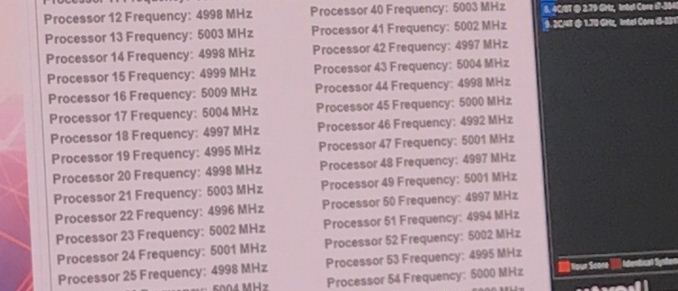
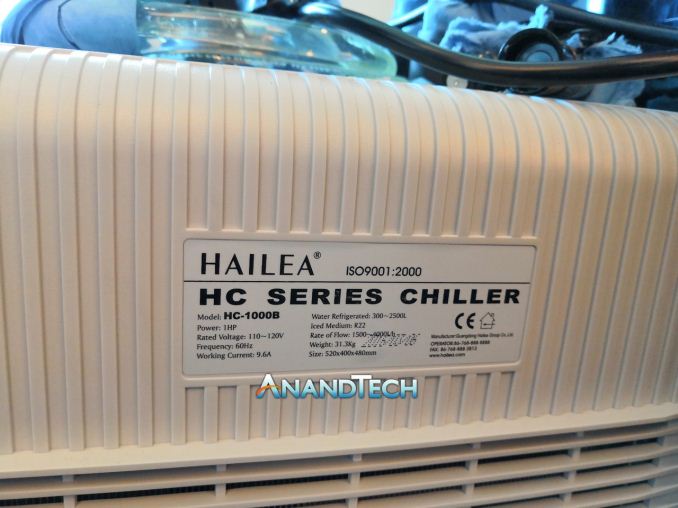
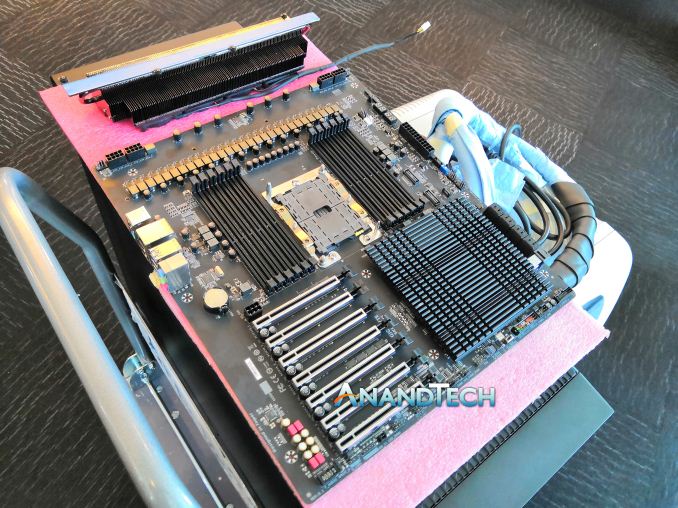
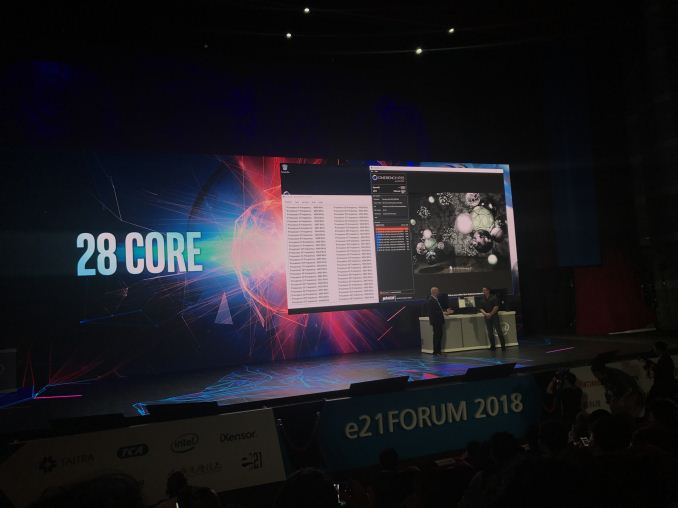








145 Comments
View All Comments
rahvin - Friday, June 8, 2018 - link
Ryan I think you should take the criticism to heart that you are taking these companies at their word far to easily. Though you should ignore the whole conspiracy issue for what it is, a conspiracy theory.There were too many things that screamed this was a setup that didn't even get mentioned. The first commenters on the article mentioned that the pictures showed what appeared to be an extreme overclocking with insulated water lines and massive VRM heatsink.
Both AMD and Intel have shown time and again that you can't take them at their word all the time. I'm not saying believe them outright, but you should be skeptical of anything they present where they are obviously concealing details. This whole presentation was stinky, and it was apparent that along with Intel's evasiveness it should have been taken very skeptically. Instead Anandtech did what every other tech publication did and presenting a glowing picture, then corrected it later when the public through comments showed the problems that were completely missed by the publisher.
close - Friday, June 8, 2018 - link
@Ryan so as a reader am I to believe that you couldn't tell the difference between what's realistically achievable with current CPU tech and some pony show put up by Intel?And when you did realize you were obviously lied to and manipulated into lying to your readers you chose to be so very delicate towards Intel and almost find excuses for them because "you care too much"?
The reader should be your priority. And as you can see so many readers are disappointed in the way you're approaching this, in the fact that you're obviously soft on Intel and it certainly looks like you're NOT impartial. A comment is not the way to address that.
But I guess you don't want to adress that. Someone will be upset either way and you'd rather it be the readers. ;)
Targon - Tuesday, June 12, 2018 - link
To be fair, when there is a generational jump, moving to 10nm for instance, it MIGHT be possible to see a big jump in terms of clock speeds. 10nm is something that Intel has been working on for a LONG time, and it is sometimes possible that there will be a big announcement that makes things interesting.Ryzen had a lot of people assuming that AMD was making a lot of noise about another CPU that wouldn't be able to compete last year, and here we are today talking about Intel trying to compete with what AMD has been able to release and not the other way around.
azanimefan - Saturday, June 9, 2018 - link
Ryan,I am currently not in journalism, but I did minor in journalism. The first rule of GOOD journalism is to DOUBT EVERYTHING, I learned that in JOUR 205 – Reporting the News. I am sure Ian thought what he was writing was true in the original article, and the contents of the article likely weren't influenced by a major advertiser on your site. The problem is most of the knowledgeable tech journalists were highly skeptical of Intel's claims BEFORE news broke about the water chiller ($600-$1000 unit), the custom made - non consumer ready 28 phase LGA 3647 tech demo motherboard (28 phase? can you imagine how much that might run) using a non-standard (actually not even consumer available) VRM cooling solution; most the the non-credulous press were doing the basic math and coming up with possible power draws for the chip in the +1000 W range (the best numbers I saw put it around 1300W) and wondering how this could be possible when Intel couldn't even get a 6 core cpu to launch at 5ghz stock.
Why didn't Ian ask these questions like the good reporters did? I can answer that. He either a) doesn't know squat about what he's reporting (possible), OR he doesn't know how to be non-credulous, OR he let his personal biases prevent him from asking the hard questions. Either way this is horrible journalism. We have a journalist who
1. doesn't know the subject he's writing about
2. doesn't know how to not be credulous
3. allows his personal preferences and biases to influence his reporting to such an extent he forgets everything he knows about computers in order to masquerade as a propagandist for favored companies.
Whichever of the 3 reasons for his first click bait style article; he displayed shockingly poor journalistic skills. The fact that you (his editor?) are defending your journalist does make you a good boss. Unfortunately it also makes you a bad editor. With you at the helm I highly suspect articles as intentionally or unintentionally dishonest as the former one, regularly get published with little to no criticism from you or the editing staff. Furthermore, instead of apologizing for the embarrassingly misleading and polite fluff pieces for Intel we're getting here from Ian, or being angry that someone in the industry effectively pulled a wizard of oz on your credulous butts, you're angry at your readers for getting mad at being mislead by a site they used to trust.
Wrong direction to direct your ire, Ryan. You should be mad at Ian for even allowing your readers to suspect his journalism was bought and paid for. Not mad at the readers for suspecting the reasons behind this shoddy journalism. You want to know why people don't trust the tech press? Its because members of the tech press HAVE taken bribes and caved to threats for good reviews. It happens in the tech press depressingly a lot. This used to be a pretty good source of trustworthy news. After seeing your post, and Ian's "correction" to that nearly propaganda puff piece he wrote, I'm sadly going to have to toss this site in with the rest of the dubious trash out there.
close - Sunday, June 10, 2018 - link
Ryan insists that "That no one told us what to write." Yet he is not willing to shed any light on why they (Anandtech) are the *ONLY* major tech site to fall for Intel's deception without a hint of cynicism or skepticism, and then not publish a scathing update.No, they wholeheartedly embraced Intel's story when it broke and could only come back with "Intel could have done this better" update after the revelation that the whole audience were taken for fools.
So absent any "sponsorship", what prevented you from spotting the deception or from justifiably and openly criticizing Intel for this? "Skill"? "Spine"?
And please don't say you "care too much" again. Other journalists that care a lot still managed to be skeptical of the original details and then point out in the update that Intel purposely mislead everyone.
So, skill, spine, or sponsorship?
eva02langley - Sunday, June 10, 2018 - link
Hey, you are going too far. Ian was THE GUY putting the whole Ryzen Fall and CTS-Labs story for what it was. AT was at the fore front there and they did an incredible job.Here, they just didn't put enough criticism in place and took Intel words a little too trustworthy. Intel DID present a 28 cores CPU running at 5GHz, however it was their deceiving intent that was of Ethical concern. They sold the story like it was a new product that anybody could purchase. They even got the guts to promote it as a HEDT product. All this was intentional and aimed at TR 32 cores. They used the press to sabotage the momentum and it did succeed.
All in all, I bet that Intel knew what they were doing and they decided to go this way and prepare the apologize story way ahead. For them, it was worth it on the short term, but I think they underestimate social media power now a day. Not even an Intel supporter can abide by something like this.
close - Monday, June 11, 2018 - link
I gave both of them the benefit of the doubt and asked to let those silly readers of theirs know:* why the title of the original article hasn't changed although it's a lie for all intents and purposes;
* why the "reveal" article is so incredibly soft that it's basically trying to put out the fire for Intel;
* why did they put 5GHz in the title when the picture they took with their own hands showed 2.7GHz base clock;
* why is there so much disparity between AnandTech reaction and every other tech outlet out there, including the reputable ones.
Did you see any answers? Maybe Ryan and Ian write for themselves and the readers are an afterthought. Or do you consider saying "we're to professional to reply publicly" (after being lied and embarrassed publicly) and that "we care too much" as an answer? How is any of this preventing them from having a proper response only they know.
And you have a very shaky understanding of what "Intel launches 28 core 5GHz CPU in Q4" means. Just suggesting that a journalist should be allowed to play with semantics like this disqualifies you from any conversation regarding ethics and professionalism. They mislead the reader and the admission and subsequent write-ups were done in a very hamfisted manner.
So no, I am definitely NOT going too far. Whatever comes now for AT is too little too late.
u.of.ipod - Friday, June 8, 2018 - link
I would love if Anandtech could spend 1 more minute of effort to not make the watermarked photos look terrible.Ryan Smith - Friday, June 8, 2018 - link
Most of these photos are taken on the fly; we're rarely given opportunities to take our time and properly stage a photo.Still, is there something specific about the watermarked photos that you don't like?
SaturnusDK - Saturday, June 9, 2018 - link
How about the image of the chiller specs where it says loud and clear it uses the internationally banned R22 ozone depleting gas? And even sports the fake CE "China Export" mark?